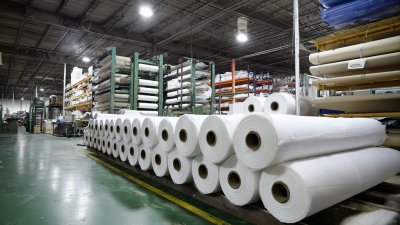Leave Your Message
In the quest for cleaner indoor air, selecting the **Best Pleated Air Filter Material** is crucial for maintaining a healthy environment. According to the U.S. Environmental Protection Agency (EPA), indoor air can be up to five times more polluted than outdoor air, making effective filtration more important than ever. Studies indicate that high-efficiency particulate air (HEPA) filters can remove at least 99.97% of airborne particles that are 0.3 microns in size, underscoring the need for quality materials in air filters. Furthermore, the American Lung Association reports that improper filtration can lead to a range of respiratory issues and exacerbate health conditions such as asthma and allergies. By understanding the various types of pleated filter materials available, consumers can make informed decisions that enhance their air quality and well-being. This guide aims to navigate through the complexities of air filter materials, ensuring you choose the best option tailored to your needs.

When it comes to selecting the best pleated air filter material, understanding the key components and their benefits is essential for maintaining clean air quality.
Pleated air filters utilize various materials, each offering distinct advantages. Common materials include synthetic fibers, which are known for their durability and efficiency in trapping particles, and natural fibers, which can provide sufficient filtration while being environmentally friendly.
Choosing the right material affects the filter's lifespan, air flow, and overall performance.
One of the core benefits of pleated air filters is their increased surface area, which enhances the filter's ability to capture dust, allergens, and other pollutants. These filters can effectively improve indoor air quality by reducing the presence of harmful particles.
Additionally, selecting a high-quality material can lead to better overall air flow efficiency within your HVAC system, which not only helps maintain a comfortable environment but also contributes to energy savings.
Therefore, understanding the different materials available is crucial in making an informed choice that meets your specific air quality needs.

When selecting pleated air filters, understanding MERV (Minimum Efficiency Reporting Value) ratings is essential for assessing filter efficiency. MERV ratings range from 1 to 16, indicating the filter's ability to remove particles of varying sizes. According to the American Society of Heating, Refrigerating and Air-Conditioning Engineers (ASHRAE), filters with a MERV rating of 1-4 are typically used in residential settings, capturing larger particles like dust and pollen. In contrast, filters rated MERV 8-13 can remove smaller particles, including mold spores and pet dander, making them ideal for homes with allergies or respiratory issues.
Furthermore, a higher MERV rating, while generally indicating better efficiency, is not always the best choice for every system. Data from the U.S. Environmental Protection Agency (EPA) show that filters rated MERV 14-16, which can trap particles as small as 0.3 microns, are often used in commercial and industrial applications. However, these high-efficiency filters can restrict airflow in systems designed for lower rated filters, potentially leading to increased energy costs and system strain. Therefore, it’s crucial to balance filter efficiency with your HVAC system's specifications and ensure optimal air quality without compromising performance.
When it comes to selecting the right pleated air filter, understanding your specific air quality needs is essential. Different environments require different levels of filtration efficiency. For instance, households with pets or smokers benefit from high-efficiency filters since they can trap larger particles like pet dander and tobacco smoke.
HEPA filters, known for their superior performance, are ideal in such scenarios, providing a robust solution for capturing allergens and pollutants.
In contrast, spaces with less indoor air pollution, such as offices or rooms with minimal outdoor exposure, might only need standard filters. These typically use polyester or fiberglass media, which can effectively manage regular dust and particulate matter without the added cost of high-efficiency options. The key is to assess your specific air quality demands. By choosing the appropriate pleated air filter material, you can ensure optimal air quality, enhancing both your health and comfort in any environment.

Maintaining the lifespan and effectiveness of pleated air filters is crucial for optimizing indoor air quality. According to the American Lung Association, well-maintained air filters can capture over 90% of airborne particles, which is essential for reducing allergens and pollutants in the home. Regular maintenance not only improves filtration efficiency but also extends the life of the filter. It is recommended to check the filters monthly and replace them every three months, or sooner if you have pets or live in a high-pollen area.
Additionally, the Environmental Protection Agency suggests using HEPA (High-Efficiency Particulate Air) filters, which can trap particles as small as 0.3 microns, for maximum effectiveness. Investing in a quality filter that matches your HVAC system’s specifications can enhance performance. Proper installation and sealing around the filter will also prevent unfiltered air from entering the system, ensuring that air passing through the filter is fully cleaned. Selecting the right material and implementing a regular maintenance schedule can dramatically improve air quality and filter longevity, contributing to a healthier living environment.
| Material Type | Efficiency Rating (%) | Lifespan (Months) | Maintenance Tip |
|---|---|---|---|
| Pleated Polyester | 85 | 6 | Replace every 6 months. |
| Electrostatic Filter | 90 | 12 | Wash monthly to maintain performance. |
| MERV 13 Rated | 95 | 3-6 | Check monthly and replace as needed. |
| HEPA Filter | 99 | 12-24 | Change at least once a year. |
| Activated Carbon | 85 | 6 | Replace every 6 months for odor control. |
When choosing pleated air filters, considering the environmental impact is crucial for promoting cleaner air and a healthier planet. Eco-friendly filter options, often made from sustainable materials, help reduce landfill waste and minimize the carbon footprint associated with manufacturing processes. Filters made from recycled materials or natural fibers not only perform effectively but also contribute to reducing environmental harm, making them a smart choice for conscientious consumers.
**Tips for selecting eco-friendly air filters:**
1. Look for filters that are made from recycled or biodegradable materials. These options often have a lower environmental impact compared to traditional synthetic filters.
2. Check for certifications such as Green Seal or ENERGY STAR, which indicate that the filter meets strict environmental standards.
3. Consider the lifespan of the filter; choosing a longer-lasting product can reduce waste and the need for frequent replacements.
By prioritizing eco-friendly air filter materials, consumers can significantly contribute to achieving cleaner air while supporting sustainable practices in the air filtration industry. Selecting the right filter not only benefits individual health but also promotes a collective effort towards environmental sustainability.
This chart illustrates the environmental impact scores of various air filter materials. A lower score indicates a more eco-friendly choice, making it easier for consumers to select the best option for clean air and sustainability.




